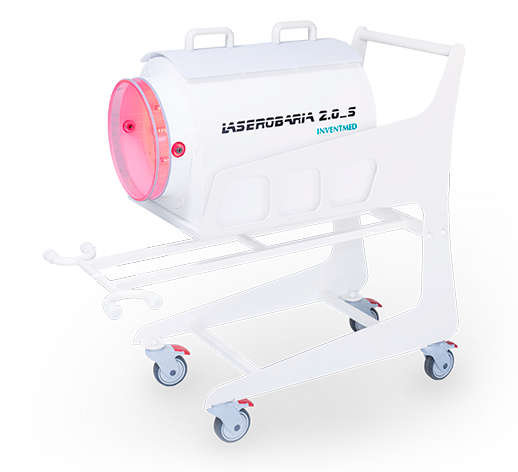VASCULAR / WOUND CARE
Vascular/wound care indications::
- Complications of diabetes, including diabetic foot,,
- diabetic microangiopathy,,
- amputation wounds,,
- Post-operative wounds,,
- burn lesions of the extremities,,
- Ulcers of the lower extremities, decubitus ulcers,,
- hard-to-heal limb wounds,,
- Chronic wounds on the background of venous insufficiency and arterial vascularity,
- purulent skin infections,
- Edema of lymphatic etiology.
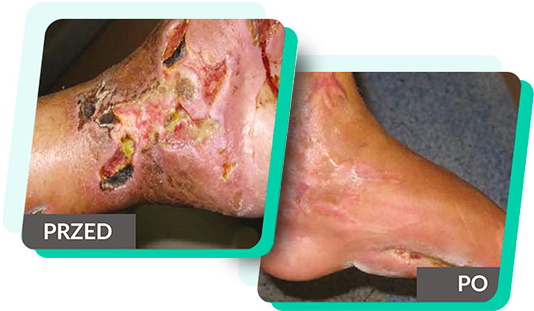
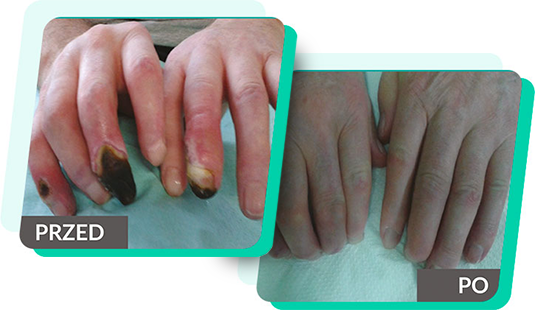

An improperly treated wound in a state of critical colonization can progress to a state of local infection, and in the next stage to whole body infection. In order to prevent a severe systemic infection – an immediate threat to the patient’s life, doctors are often forced to decide on the amputation of the part of the limb affected by the severe wound infection. All possible measures should be taken to prevent this from happening.
To effectively prevent the development of wound infection, the European Wound Healing Society proposes the TIME management strategy. The acronym comes from concurrently performed steps:
T (tissue debridement) – assessment of wound condition and debridement,
I (infection and inflammation control) – control of infection and development of inflammatory process,
M (moisture balance) – maintenance of appropriate moisture level in the wound,
E (edges, epidermization stimulation) – protection of wound edges and stimulation of epidermis.
The use of Laserobaria 2.0_S supports the process of proper wound healing, especially in the area of infection control and the inflammatory process, as well as in the case of protecting the wound edges and stimulating epidermis.
Therapy with the Laserobaria 2.0_S device allows topical applications of potent biocides, such as ozone and UV light, which show high efficacy in biofilm reduction. Topical oxygen therapy, pulsed electromagnetic field stimulation and red light stimulate the epidermal process. Other features of magnetotherapy are the observed accelerated bone fusion, enhancement of the process of angiogenesis, strong analgesic properties.
Daily treatment of the patient further promotes regular assessment of the wound condition and its cleaning in the process of preparing the limb for therapy by personnel qualified to do so. An additional benefit is the maintenance of adequate moisture levels through regular dressing changes.
A great advantage of the device is the ability to conduct personalized therapy, interacting with all therapeutic agents at different intensities, during a single treatment. At different stages of recovery, the parameters of therapy can change, responding to changing wound conditions
WHAT ARE THE DIRECT BENEFITS OF THE TREATMENT METHODS USED IN LASEROBARIA 2.0 S?
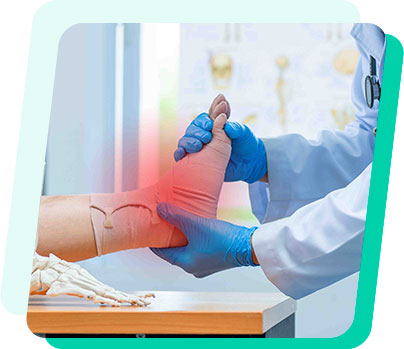
SOLVING DIABETES-RELATED PROBLEMS
Diabetic patients have a high percentage of damaged nerves or blood vessels, resulting in loss of sensation in the feet. Patients may even stop feeling cuts in the skin, blisters or ulcers that have formed.
LASEROBARIA 2.0_S causes nerve or blood vessel damage to stop, allowing wounds, blisters, or ulcers formed on the skin to heal in a process of several days.
Damage to the blood vessels of the limbs can mean that the patient’s legs will not have enough blood and oxygen, making it difficult to step on the feet, causing significant pain and suffering for the mover.
Because LASEROBARIA 2.0_S promotes blood and oxygen supply to the limb, the therapy significantly improves mobility, reducing pain and suffering in the patient.
The occurrence of pain or infection resulting from a foot injury can cause ulcers and bacterial infections, which in many cases lead to limb amputation.
The therapy used helps inhibit the process of ulcer formation and allows wounds to heal quickly, while inhibiting the development of bacterial infections.
Severely neglected, untreated or not treated long enough, can even lead to foot amputation. LASEROBARIA 2.0_S offers a real chance for patients with a neglected, long untreated limb. It offers a chance to improve the quality of life, regain the limb’s function and thus physical fitness.
TREATMENT OF CONDITIONS RELATED TO VENOUS INSUFFICIENCY
A similar problem of hard-to-heal wounds is venous insufficiency, where blood, instead of circulating freely, stops. The discomfort occurs most quickly around the ankles. Venous blood is deprived of oxygen and contains metabolic products, so as it backs up, it weakens the surrounding tissues. As a result, pain, discoloration, skin peeling, and infections and infestations are easy. A multi-year process can lead to a wound that will not heal.
The slowing of blood flow in dilated veins is also one of the most important causes of thrombosis, an immediately life-threatening condition. Clots in the legs, or clumped blood cells, can travel to the pulmonary artery and cause it to close, known as pulmonary embolism, even leading to death.
In such a situation, the use of hyperbaric oxygen available in Laserobaria 2.0_S to improve tissue regeneration becomes the answer to the problem of an ongoing disease state. Delivering oxygen to cells in the most efficient way stimulates physiological repair processes, and the use of pressure higher than atmospheric pressure leads to oxygen getting rid of physiological barriers to penetration through tissues. This makes it possible to reach less well-blooded areas. Adding to this process the bactericidal, fungicidal and virucidal properties of ozone therapy will help control ongoing inflammation and infection, and the inclusion of a magnetic field will measurably reduce pain and rapidly improve the patient’s comfort. The use of ozone, making red blood cells less prone to “clumping” will realistically support the recovery process with an anticoagulant effect.
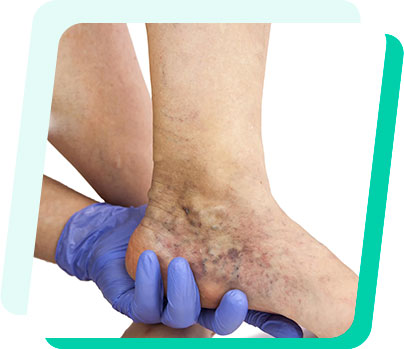
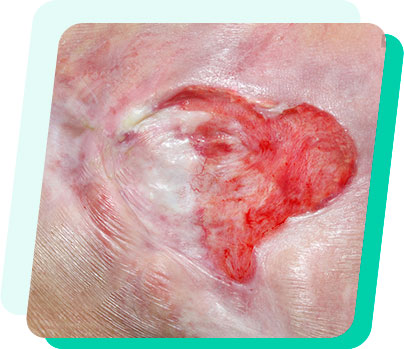
BEDSORES TREATMENT
Bedsores are a unit of disease manifested by ulceration of the skin, inflammatory lesions of the ulcerated area, inflammation of the bones and penetration of necrotic lesions into the area of muscle, tendon and fascial structures. The cause is increased, often fluctuating pressure, in most cases in the lower part of the body, acting on the skin surfaces in the sacrum, hip or heel areas. Predisposing factors are advanced age, reduced mobility and malnutrition or an unbalanced diet.
In this case, the use of Laserobaria 2.0_S therapy makes it possible to inhibit the process of ulcer formation. Oxygenation of the affected limb improves the metabolic process, thereby increasing the absorption of oxygen by the cells. In addition, ozone and UV light therapy has a detoxifying effect, delivering antibacterial, fungicidal and virucidal agents to the wound. The process of microbial proliferation is inhibited. Wound exudate decreases, ultimately leading to its elimination and healing of the decubitus wound.
TREATMENT OF LIMB BURNS
Burns are one of the most common injuries in children. Burns are most common in children aged 1-3 years. The younger the child, the more severe the course of burn disease. This is due to inadequate thermoregulatory mechanisms in young children, poor ability to compensate for loss of body fluid volume and low absolute volume of circulating blood. An unfavorable body surface area-to-weight ratio is also an important factor, which increases the vulnerability of young children to the development of hypovolemic shock and renal failure in the course of a burn injury.
The treatment of burn wounds in adults as well as children follows a similar course of action consisting of conservative treatment and surgical treatment as well as physical therapy using, among other things, a hyperbaric chamber, magnetic fields and lasers or gases. Therefore, also for these problems Laserobaria 2.0_S can significantly help patients, small and large. In the initial phase of treatment, the use of higher doses of magnetic fields will help control pain and promote the production of betaendorphins. In addition, the magnetic field positively affects the formation of collagen and creatine, and at the same time will act on the structures of cell membranes affecting their properties and stimulating the enzymatic immune response of the body. Hyperbaric oxygen therapy, slow magnetic field
stimulation and red band light will stimulate the epidermal process. The use of all the methods available at Laserobaria 2.0_S will initiate the skin’s natural healing processes, giving you a real chance to return to full function.
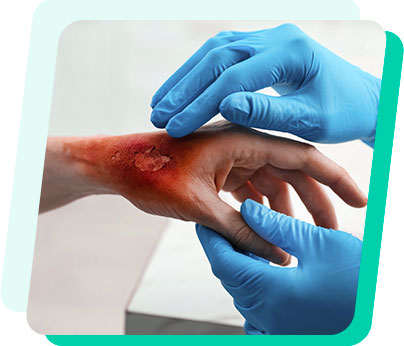
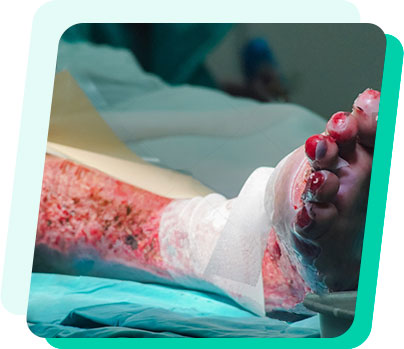
TREATMENT OF HARD-TO-HEAL SURGICAL WOUNDS / POST-OPERATIVE INFLAMMATION
Difficult-to-heal surgical wounds pose a significant clinical problem for both patient and physician. They are primarily associated with a reduction in the patient’s quality of life and can result in life-threatening systemic complications. They are also a problem from the point of view of the economic burden on the hospital and the health care system. Difficult-to-heal wounds include wounds that do not heal by debridement or by granulation, and there are complications in the healing process that delay or prevent wound healing. The most common wound healing complications include infection, wound dehiscence and the formation of abnormal scars.
One of the most serious complications is surgical wound infections. Most wounds, whether chronic, acute traumatic or surgical, are microbiologically contaminated to some degree. Depending on the severity of the contamination, complications can arise, such as delayed healing, the development of local or systemic infection, in extreme cases complicated by sepsis.
Supporting the post-operative period with access to the innovative Laserobaria 2.0_S solution dramatically accelerates recovery time, lowering the risk of complications. The patient can be discharged from the medical facility faster and in a better overall condition, further reducing the likelihood of his or her return as a result of possible side effects specific to the postoperative period. Equipping the post-operative protocol with physical treatment using anti-inflammatory, bacterial, viral, fungicidal agents, promoting the process of tissue regeneration and with additional analgesic effects, raises the rate of surgical procedures completed with improvement in the Patient’s health. Its result is a higher percentage of Patients returning to full function.
CASE STUDY
Male, age: 54
Wound of the left lower leg. Concurrent drug treatment. History of varicose veins for many years. Clinical picture: visible two wounds on the lower leg with swelling of the limb and large trophic changes involving the entire lower leg. Small wounds on the foot between the toes and on the sole. Physical therapy was recommended. Laser therapy was recommended
The first phase applied:
- Ozone: 15min
- Field: 5Hz, 4mT, triangular waveform, 10min
- Oxygen: 500Pa, 30min
- Red Light: 0.42J/cm^2, 5min.
In the next phase, it was applied:
- Ozone: 15 min
- Oxygen: 500Pa, 25 min
- Red light: 0.84 J/cm^2, 10 min.
Results:
After the first few sessions, an analgesic effect was obtained, reducing swelling. The healing process as shown in the images below.
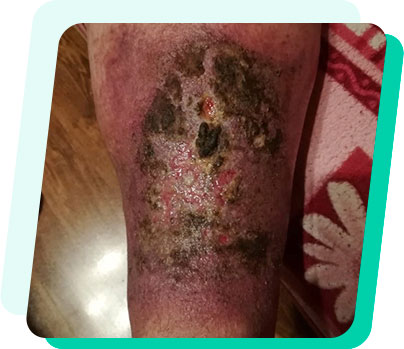
Wound before treatment

Wound after the first treatment cycle
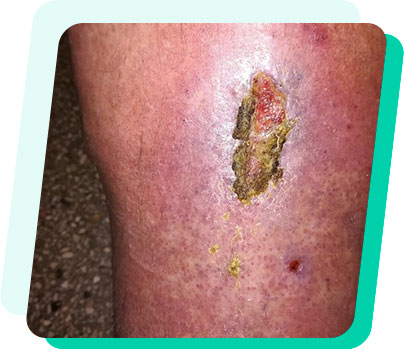
Wound during the second cycle
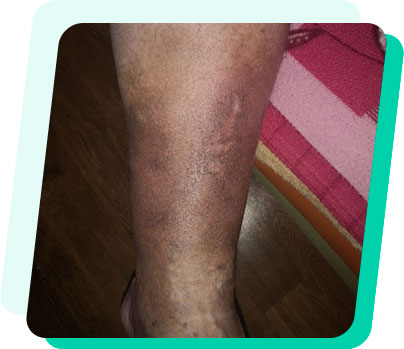
Wound 14 days after the end of the third cycle
